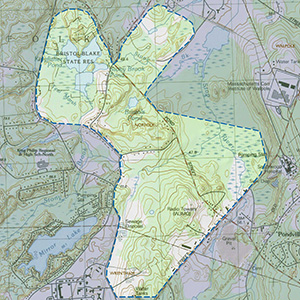Important Bird Area Sites in Massachusetts
Important Bird Area: Stop River
Site Summary
Nominated By
Jack Lash
Size
2,000 acres
Towns and Counties
Norfolk, Wrentham; Norfolk
Ownership
state, municipal, nongovernmental organization
Major Habitats
oak-conifer forest, early successional shrubland, cultural grassland, emergent freshwater wetland, power line, shrub-scrub wetland, lake/pond, river/stream, hawk watching site, migratory stopover site
Land Use
nature & wildlife, conservation/land trust, hunting & fishing, other recreation, agriculture/livestock, water supply
IBA Criteria
- Category 1: Sites important for long-term research and/or monitoring projects that contribute substantially to ornithology, bird conservation, and/or education.
- Category 4: Sites containing assemblages of species characteristic of a representative, rare, threatened, or unique habitat within the state or region.
- Category 5: Land Birds: The site is an important migratory stopover or seasonal concentration site for migratory land birds (e.g., warblers). Sites may also qualify on the basis of supporting exceptionally high densities of breeding species as shown from point counts or other surveys or if they represent "migrant traps" relative to surrounding areas. Strong consideration will be given to areas with consistently high overall species diversity..
Site Description
This IBA is bisected by Route 115, at the Norfolk Wrentham line, and is north of Route 1A. Habitats include; fields: both mowed and unmowed, young woodlands and mature forests, and assorted wetlands including lakes, ponds, river and streams. Woodlands, fields, and impounded undisturbed wetlands owned by Massachusetts Corrections Institute (MCI) and Mass Audubon/DCR have significant plant diversity.
Current Conservation Status
This site consists of land owned by Department of Mental Health (DMH), Wrentham Development Center, Lind Farm Conservation Land, Mass Audubon's 245-acre Stony Brook Wildlife Sanctuary, (co-owned with the Department of Conservation and Recreation), and the MCI. Some field habitats were recently converted to playfields, cellular towers are visible in several directions, and ORV-ATV use in woodlands is seasonally active. A model-airplane club has a lease for use on five to six acres. The DMH wooded trails are popular with dog walkers. Two hundred acres are open to horses. The MCI cell towers limit access, to a permit-based group, three or four times a year. The Mute Swan, an invasive bird, is present on MCI property. Invasive non-native flora within the nominated area include: Autumn Olive, barberry, Callery Pear, buckthorn, Multiflora Rose, Greenbriar, and Norway Maple. Bristol Blake State Reservation is on the National Register of Historic Places. The Wrentham Open Space Committee and DMH managers have focused upon habitat importance, diversity, protection, and management.
Ornithological Significance
State-listed species that breed or migrate through this area include the Sharp-shinned Hawk, Northern Harrier, Pied-billed Grebe, and Northern Parula. Significant numbers of breeding and wintering waterfowl 100+ pairs; Christmas Bird Counts (CBC) since 1987 include fifteen plus species at Stony Brook Wildlife Sanctuary and MCI-Norfolk; and wading bird habitat includes a heron rookery at MCI. At least two regional high conservation priority species, and one-state high conservation priority species breed within the area. Long-term census done by Stony Brook Club; Breeding Bird Surveys, CBC, and winter counts. Northeast regional grassland bird survey performed on DMH property 1999, 2000.
Other Flora or Fauna of Significance
Stony Brook Wildlife Sanctuary/Bristol Blake State Reservation hosts one rare plan spotted turtles. River Otters and Mink frequent the Stop River and connecting ponds and wetlands. Fishers spotted with increasing frequency at all four areas; MCI, DCR, Mass Audubon, and DMH. Lind Farm Conservation Land contains large vernal pool, hosting Wood Frogs, and Green Frogs and numerous Spring Peepers. The Massachusetts Butterfly Club does annual counts within this IBA.
Data Sources
Breeding Bird Survey (Petersen & Veit, DeGraaf); Christmas Bird Count since 1987 (Millis Circle Data); Winter Counts (personal observations of: J. Lash, M. Grzenda, C. Walker, et al)




